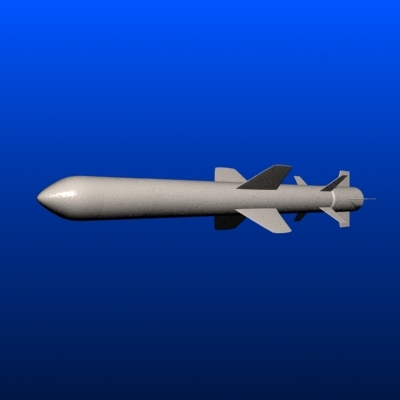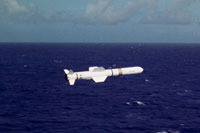
After launch, the DC/PS uses the missile acceleration data from the ARA and altitude data from the radar altimeter to maintain the missile on the programmed flight profile.

Prior to launch, the DC/PS is initialized with data by the Command Launch System. The MGU consists of a three-axis attitude reference assembly (ARA) and a digital computer/power supply (DC/PS). The Guidance Section consists of an active radar seeker and radome, Missile Guidance Unit (MGU), radar altimeter and antennas, and power converter. This allows firing from higher altitudes and longer range flights. Depending upon launch conditions, the Harpoon engine generally will not start until after the missile is dropped from the wing. Aircraft launched Harpoons do not require a Booster. When the capsule breaches the surface, the top is blown off and the missile is launched.

Submarines fire a capsule containing the Harpoon from their torpedo tubes. This allows the firing platform to engage other threats instead of concentrating on one at a time.Īn appropriately configured HARPOON can be launched from an AERO-65 bomb rack, AERO-7/A bomb rack, MK 6 canister, MK 7 shock resistant canister, MK 12 thickwall canister, MK 112 ASROC launcher, MK 8 and MK 116 TARTAR launcher, or submarine torpedo tube launcher. Once fired, the missile flys to the target location, turns on its seeker, locates the target and strikes it without further action from the firing platform. Once targeting information is obtained and sent to the Harpoon missile, it is fired. Other weapons (such as the Standard and Tomahawk missiles) can be used against ships, but Harpoon and Penguin are the only missiles used by the United States military with anti-ship warfare as the primary mission. The Harpoon missile was designed to sink warships in an open-ocean environment. The Harpoon missile and its launch control equipment provide the warfighter capability to interdict ships at ranges well beyond those of other aircraft. Its low-level, sea-skimming cruise trajectory, active radar guidance and warhead design assure high survivability and effectiveness.

The weapon system uses mid-course guidance with a radar seeker to attack surface ships. The Harpoon missile provides the Navy and the Air Force with a common missile for air, ship, and submarine launches. AGM-84 Harpoon/SLAM - Smart Weapons FAS |


 0 kommentar(er)
0 kommentar(er)
